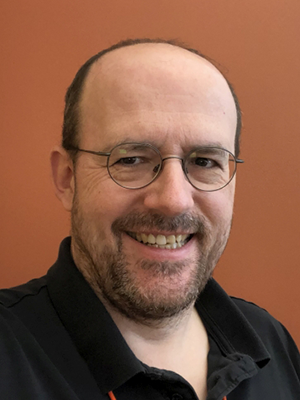NICHD Microscopy and Imaging Core
- Vincent Schram,
PhD, Executive Director - Tamás Balla,
MD, PhD, Scientific and Administrative Director - Ling Yi, PhD, Staff Scientist
- Louis (Chip) Dye, BS, Research Assistant

The mission of the NICHD Microscopy and Imaging Core (MIC) is to provide service in four different areas:
- histology and sample preparation for light and electron microscopy;
- wide-field and confocal light microscopy;
- transmission electron microscopy (TEM); and
- image analysis and data extraction.
The Facility operates as a one-stop shop, where investigators can go from their scientific question to the final data with a minimum of effort.
Mode of operation
Located on the ground floor of the Porter Building (Building 35A), the MIC is accessible 24/7. Users can reserve time on each microscope by using an online calendar (https://nichd.agendoscience.com). The facility is available free of charge to all NICHD investigators and, resources allowing, to anyone within the Porter building. The facility is supported by the Office of the Scientific Director, NICHD.
Vincent Schram is the point person for light microscopy and data analysis and acts as team lead. Ling Yi is in charge of the histology/sample preparation unit. The electron microscopy (EM) branch of the facility is staffed by Chip Dye. Tamás Balla is the scientific and administrative director of the Core.
The MIC has an open-door policy with the NINDS Light Imaging Facility (LIF) in building 35. The two cores exchange users, share equipment, and trade support. Although not officially sanctioned, this mode of operation provides extended support hours, wider expertise, and access to more equipment than each Institute could afford on its own.
The MIC serves over 300 registered users in 68 laboratories. NICHD uses 80% of the facility's resources, NINDS 15%, and other Institutes (NIBIB, NIA, and NIMH) the remaining 5%.
Histology and sample preparation
Staffed by Ling Yi, the histology/sample preparation lab is the most important component of the MIC. In the past 12 months, more than 100 scientists were trained in person in rodent perfusion, cryopreservation, cryo-sectioning, immunofluorescence, and RNAscope.
Dr. Yi spent a significant amount of time creating and updating protocols that were uploaded to the MIC site (tissue clearing, RNAscope, auto-fluorescence quenching). She also optimized methods for cyclic (high-count) immunofluorescence staining, and interfaced with Vivek Mahadevan (NICHD Molecular Genetic Core) on tissue preparation protocols for transcriptomics sequencing and imaging.
Light microscopy
The MIC is equipped with six confocal microscopes, each optimized for certain applications: (1) a Zeiss LSM 900 equipped with an Airyscan detector; (2) a Zeiss LSM 980 equipped for super-resolution (Airyscan) with an extended selection of laser lines; (3) a Zeiss 800 for basic confocal imaging; (4) a Zeiss 880 with an Airyscan detector; (5) a high-end Leica Stellaris equipped for fluorescence lifetime and super-resolution (STED); and (6) a Nikon spinning disk capable of total internal reflection fluorescence imaging.
The facility operates two automated slide scanners, a Zeiss Axioscan 7 and an older Zeiss Axioscan Z1. Both scanners are heavily used and free up hundreds of personnel hours for many research groups in the DIR. A regular wide-field fluorescence microscope for non-confocal imaging is also available.
We provide image analysis services based on ImageJ, Zeiss Zen, Nikon Elements, and Bitplane Imaris. NIH's Information Resource Management Branch (IRMB) restored some level of connectivity to the internet and to the Institute's file server, a vast improvement over the previous two years.
The light microscopy branch of the MIC continues to follow the following mode of operation: each project is first researched by the staff, and the best approach is decided upon in consultation with the users; the end users then receive hands-on training on the equipment and software best suited to their goals, followed by continuous support, as required; once image acquisition is complete, the staff devise solutions and train users on how to extract usable data from their images.
Electron microscopy
The electron microscopy section of the facility processes specimens from start to finish: fixation, embedding, semi-thin and ultra-thin sectioning, staining, and imaging on the JEOL 1400 transmission electron microscope. Because of the labor involved, the volume is necessarily smaller than for the light microscopy branch, in which end users perform their own processing and imaging. In the past 12 months, Louis Dye processed 415 resin blocks from samples submitted by 10 investigators.
Mr. Dye also attended a training event on the Tokuyasu cryo-sectioning technique in Utrecht, the Netherlands. The method is the preferred standard in membrane identification combined with antibody labeling. Mr. Dye is in the process of setting up this high-end cryo-EM technique using a few projects before offering it to the community.
Dr. John Heuser, a world-renowned electron microscopist, continues to use the MIC resources to advance sophisticated EM projects within the DIR.
Image analysis
As mentioned above, the MIC continues to provide image processing based on ImageJ, Zeiss Zen, Nikon Element, and Bitplane Imaris. For difficult cases, in which conventional processing is not suitable, the Nikon NIS-AI suite provides sophisticated tools for image restoration, segmentation, and feature extraction.
Collaborators
- John Heuser, PhD, Section on Integrative Biophysics, NICHD, Bethesda, MD
Contact
For more information, email schramv@mail.nih.gov or visit https://www.nichd.nih.gov/about/org/dir/other-facilities/cores/microscopyandimaging.

